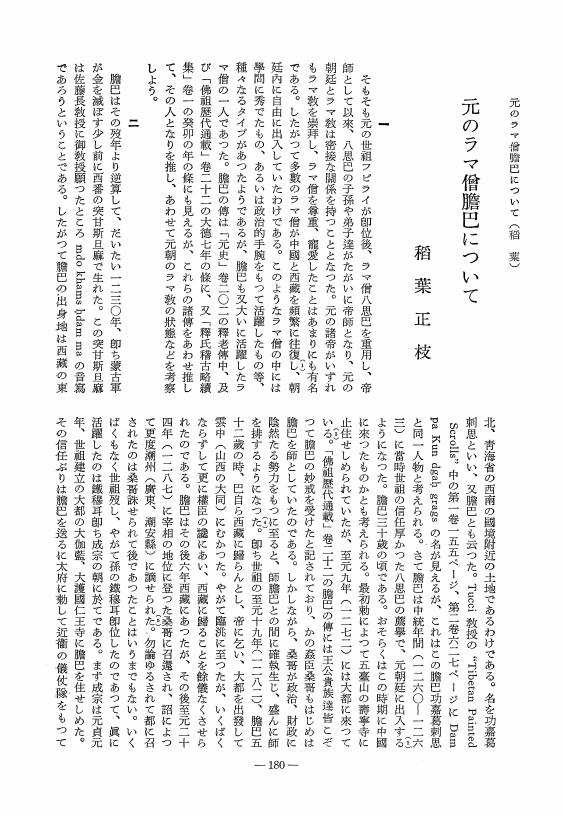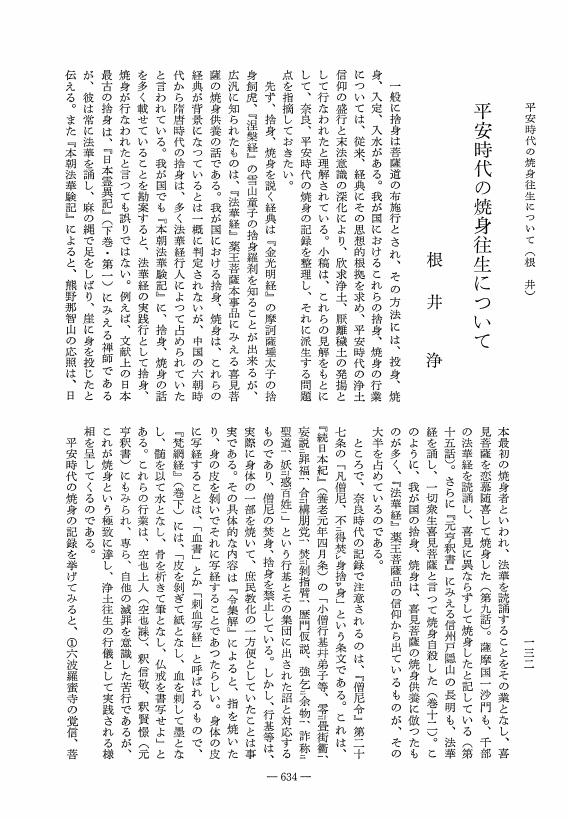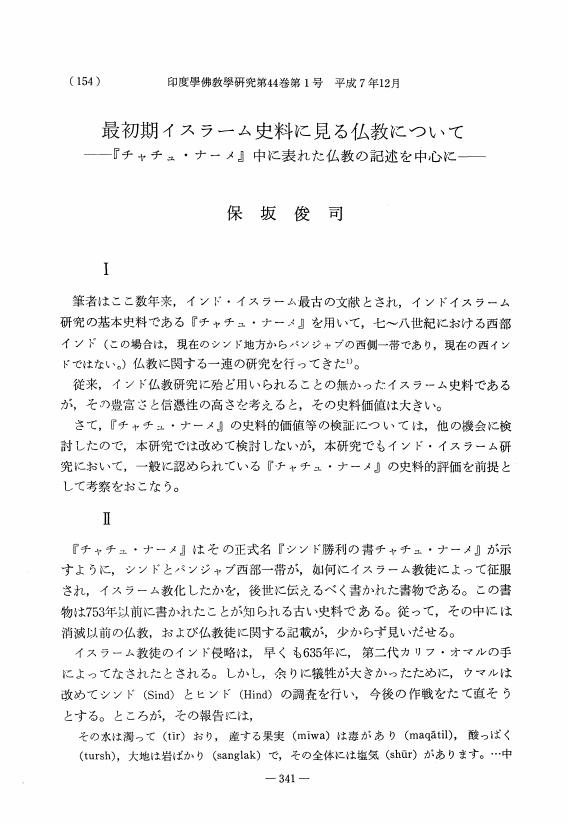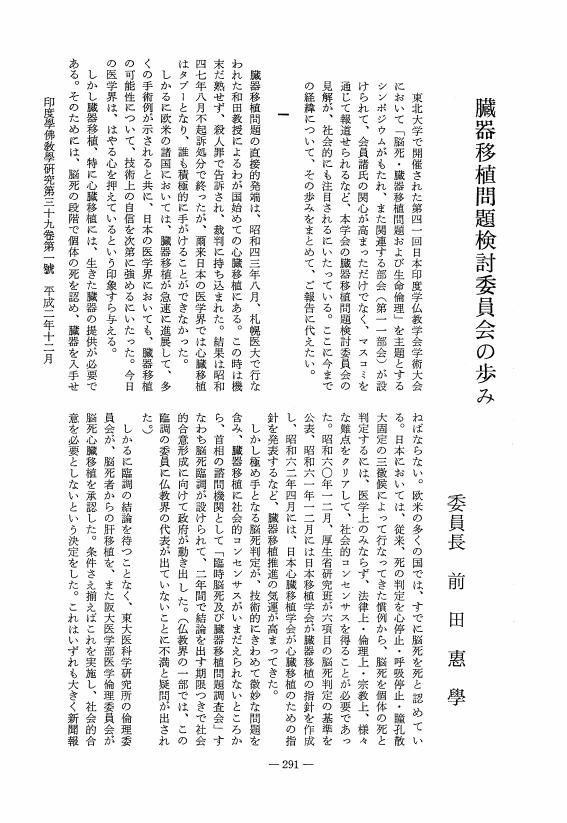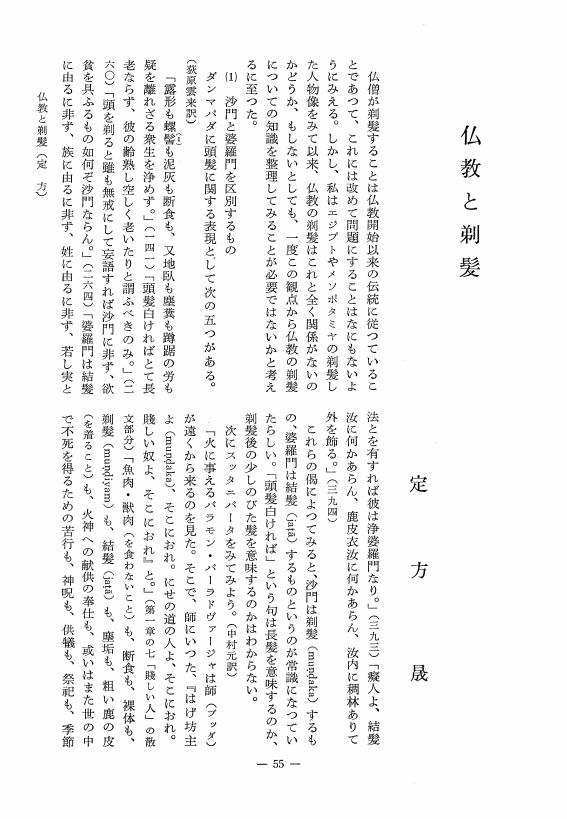343 0 0 0 OA 『金剛般若経』に見られる「即非の論理」批判
- 著者
- 立川 武蔵
- 出版者
- Japanese Association of Indian and Buddhist Studies
- 雑誌
- 印度學佛教學研究 (ISSN:00194344)
- 巻号頁・発行日
- vol.41, no.2, pp.987-984, 1993-03-25 (Released:2010-03-09)
- 参考文献数
- 3
39 0 0 0 OA 阿毘達磨仏説論と大乗仏説論 -法性, 隠没経, 密意-
- 著者
- 本庄 良文
- 出版者
- Japanese Association of Indian and Buddhist Studies
- 雑誌
- 印度學佛教學研究 (ISSN:00194344)
- 巻号頁・発行日
- vol.38, no.1, pp.410-405, 1989-12-20 (Released:2010-03-09)
24 0 0 0 OA 「憲法十七条」が想定している争乱
- 著者
- 石井 公成
- 出版者
- Japanese Association of Indian and Buddhist Studies
- 雑誌
- 印度學佛教學研究 (ISSN:00194344)
- 巻号頁・発行日
- vol.41, no.1, pp.133-139, 1992-12-20 (Released:2010-03-09)
17 0 0 0 OA 叙事詩『マハーバーラタ』におけるスータについて
- 著者
- 石原 美里
- 出版者
- Japanese Association of Indian and Buddhist Studies
- 雑誌
- 印度學佛教學研究 (ISSN:00194344)
- 巻号頁・発行日
- vol.60, no.3, pp.1138-1142, 2012-03-25 (Released:2017-09-01)
「スータ」という語はこれまで「御者」,「吟誦詩人」と訳されることが多かったが,多くのスータに関する叙述を収集・分析すると,その人物像は非常に曖昧で一貫性がなく,「御者」,「吟誦詩人」という一言では片付けられない複雑さを孕んでいる.本研究では,『マハーバーラタ』に登場するサンジャヤという王の側近であるスータが,ヴェーダ文献に見られるスータ像をある程度反映しているものと仮定して,そのスータ像の変遷を追った.このヴェーダ時代におけるスータ像は,『ヴィシュヌプラーナ』の中に収められているプリトゥ王神話におけるスータ起源譯にも反映されている.そこにおいてスータは,王のするべき行いを規定するような権力を有する王家の高官として描かれており,それを便宜的に「古型」と位置付けた.その後この「古型」は,バラモンらがスータを彼らの構想する4ヴァルナ社会に組み入れようとする際に,混合ヴァルナ身分としてのスータの裏付けとして様々に応用されたと考えられる.その一方で,スータが現実社会に存在しなくなった時代,『マハーバーラタ』の最終改編としてスータ・ウグラシュラヴァスの語りの枠が導入される.この際『マハーバーラタ』の編者らは,その語り手として「放浪の吟訥詩人」という新たなスータ像を創り上げたと推測される.その新しい語りの枠はいくつかのプラーナ文献にも採用され,その結果,放浪の吟誦詩人的スータ像と,古い伝承における王家の高官的スータ像が同文献内にも併存することになったと結論付けた.
17 0 0 0 OA 鬼神の仏教-護法神執金剛と菩薩金剛手-
- 著者
- 入澤 崇
- 出版者
- JAPANESE ASSOCIATION OF INDIAN AND BUDDHIST STUDIES
- 雑誌
- 印度學佛教學研究 (ISSN:00194344)
- 巻号頁・発行日
- vol.33, no.1, pp.144-145, 1984-12-25 (Released:2010-03-09)
14 0 0 0 OA 元のラマ僧膽巴について
- 著者
- 稻葉 正枝
- 出版者
- JAPANESE ASSOCIATION OF INDIAN AND BUDDHIST STUDIES
- 雑誌
- 印度學佛教學研究 (ISSN:00194344)
- 巻号頁・発行日
- vol.11, no.1, pp.180-182, 1963-01-15 (Released:2011-06-08)
11 0 0 0 OA 僧と陰陽師
- 著者
- 木場 明志
- 出版者
- Japanese Association of Indian and Buddhist Studies
- 雑誌
- 印度學佛教學研究 (ISSN:00194344)
- 巻号頁・発行日
- vol.26, no.2, pp.757-760, 1978-03-20 (Released:2010-03-09)
9 0 0 0 OA 平安時代の焼身往生について
- 著者
- 根井 浄
- 出版者
- Japanese Association of Indian and Buddhist Studies
- 雑誌
- 印度學佛教學研究 (ISSN:00194344)
- 巻号頁・発行日
- vol.27, no.2, pp.634-635, 1979-03-31 (Released:2010-03-09)
9 0 0 0 OA 日本梵字弥陀名号の研究
- 著者
- 斎藤 彦松
- 出版者
- Japanese Association of Indian and Buddhist Studies
- 雑誌
- 印度學佛教學研究 (ISSN:00194344)
- 巻号頁・発行日
- vol.36, no.1, pp.260-263, 1987-12-25 (Released:2010-03-09)
9 0 0 0 OA 梵字勃〓〓 Bhrum 信仰の研究
- 著者
- 齋藤 彦松
- 出版者
- Japanese Association of Indian and Buddhist Studies
- 雑誌
- 印度學佛教學研究 (ISSN:00194344)
- 巻号頁・発行日
- vol.28, no.2, pp.837-840, 1980-03-31 (Released:2010-03-09)
7 0 0 0 OA インド密教における護摩儀礼の展開
- 著者
- 森 雅秀
- 出版者
- Japanese Association of Indian and Buddhist Studies
- 雑誌
- 印度學佛教學研究 (ISSN:00194344)
- 巻号頁・発行日
- vol.42, no.1, pp.420-412, 1993-12-25 (Released:2010-03-09)
- 参考文献数
- 18
- 被引用文献数
- 1
7 0 0 0 OA 日本で発見されたオリヤー語の『マハーバーラタ』について
- 著者
- Shobha Rani DASH
- 出版者
- Japanese Association of Indian and Buddhist Studies
- 雑誌
- 印度學佛教學研究 (ISSN:00194344)
- 巻号頁・発行日
- vol.54, no.2, pp.872-869,1324, 2006-03-20 (Released:2010-07-01)
A palm leaf manuscript of the Oriya Mahabharata written by the famous Oriya poet Sudramuni Srisaraladasa of the mid 15th c. was transmitted to Tsusima-cho of Ehime prefecture in Japan during the 18th century A. D. It ia ssumed that the manuscript was transcribed in the beginning of the 17th c. It was written in the medieval Oriya language using the medieval Oriya script except the invocation to Lord Ganesa, which is in Sanskrit. It consists of 221 leaves (transcribed on both sides), a few blank leaves and a bamboo cover. In the beginning and the end of the manuscript it mentions clearly that it is the first part of the Aranyakaparba of the Mahabharata. It is a typical manuscript of Orissa, an Eastern state in India. The most interesting point to note is that it is not just an Oriya translation of the Sanskrit Mahabharata, but is an Oriya version of it. Since 2001, I have been working on its romanized edition and Japanese translation along with Mr. Nobuyuki Kashiwahara and Prof. Hojun Nagasaki as the chief. A new relationship between Orissa and Japan is expected to be explored from the research of this manuscript.
- 著者
- 宮本 正尊
- 出版者
- JAPANESE ASSOCIATION OF INDIAN AND BUDDHIST STUDIES
- 雑誌
- 印度學佛教學研究 (ISSN:00194344)
- 巻号頁・発行日
- vol.13, no.2, pp.855-845, 1965-03-31 (Released:2010-03-09)
7 0 0 0 ジャムヤン・シェーパのチベット仏教史年表
- 著者
- 西岡 祖秀
- 出版者
- JAPANESE ASSOCIATION OF INDIAN AND BUDDHIST STUDIES
- 雑誌
- 印度學佛教學研究 (ISSN:00194344)
- 巻号頁・発行日
- vol.54, no.1, pp.497-493,1285, 2005
The Chronological Table of Tibetan Buddhist history of 'Jam-dbyangs-bzhad-pa precedes the famous chronological table of Sum-pa-mkhan-po. A feature of both chronological tables is that they were written in acceptance of the legend of the country of Shambhala, as taught in the <i>Kalacakratantra</i>. Namely, they record that the 25th generation Raudracakrin king of the ideal Buddhism kingdom Shambhala will win the final war with Islam, reviving Buddhism. Sum-pa-mkhan-po projects the date of this event to be A. D. 2376.
- 著者
- 保坂 俊司
- 出版者
- JAPANESE ASSOCIATION OF INDIAN AND BUDDHIST STUDIES
- 雑誌
- 印度學佛教學研究 (ISSN:00194344)
- 巻号頁・発行日
- vol.44, no.1, pp.341-338, 1995-12-20 (Released:2010-03-09)
6 0 0 0 OA 仏典における性差別の解釈をめぐって
- 著者
- Shobha Rani DASH
- 出版者
- Japanese Association of Indian and Buddhist Studies
- 雑誌
- 印度學佛教學研究 (ISSN:00194344)
- 巻号頁・発行日
- vol.55, no.2, pp.1024-1020,1290, 2007-03-20 (Released:2010-07-01)
Previous studies state that a number of Buddhist canonical texts suggest discrimination against women, such as the Buddha's reluctance to allow women to enter the Sangha, the subordinate status of the bhikkhunis under the eight strict conditions (attha garudhamma), the inferior terms used for the women in the canonical texts, the five obstructions of a woman, her incapability to become a Buddha etc. How these discriminatory expressions gradually became hindrances to ordination of womenfolk is discussed in this paper.In this paper, the possibilities of the misreading of Buddhist texts have been examined. When reading a text, we sometimes consider the subject matter just from its ostensible meaning. This ultimately leads us into a quick mire. The problem does not lie in the scriptures themselves; rather, it is our misleading interpretation that often grows out of nuances in translation. What has come down to us today as the problem of bhikkhuni ordination or gender discrimination is possibly the outcome of misinterpretations that grew out of the socially defined realities of the times and the places where the texts were written and the linguistic demands of the target languages. This has been discussed by a close examination of key passages from Pali, Sanskrit and Chinese texts.
6 0 0 0 OA 敦煌本「大雲経疏」の研究
- 著者
- 滋野井 恬
- 出版者
- Japanese Association of Indian and Buddhist Studies
- 雑誌
- 印度學佛教學研究 (ISSN:00194344)
- 巻号頁・発行日
- vol.21, no.2, pp.836-841, 1973-03-31 (Released:2010-03-09)
6 0 0 0 OA 第四十一回学術大会シンポジウム「脳死・臓器移植問題および生命倫理」報告
- 著者
- 前田 惠學
- 出版者
- Japanese Association of Indian and Buddhist Studies
- 雑誌
- 印度學佛教學研究 (ISSN:00194344)
- 巻号頁・発行日
- vol.39, no.1, pp.291-301, 1990-12-20 (Released:2010-03-09)
6 0 0 0 OA 生きているサンスクリット
- 著者
- 中村 元
- 出版者
- Japanese Association of Indian and Buddhist Studies
- 雑誌
- 印度學佛教學研究 (ISSN:00194344)
- 巻号頁・発行日
- vol.21, no.1, pp.14-20, 1972-12-31 (Released:2010-03-09)
6 0 0 0 OA 仏教と剃髪
- 著者
- 定方 晟
- 出版者
- Japanese Association of Indian and Buddhist Studies
- 雑誌
- 印度學佛教學研究 (ISSN:00194344)
- 巻号頁・発行日
- vol.23, no.1, pp.55-60, 1974-12-25 (Released:2010-03-09)




